Exploring Your Roofing Options: A Comprehensive Guide to 12 Types of Roofing Materials and Their Costs.
With a myriad of roofing materials available, ranging from the traditional to the innovative, it’s a wise decision to consider all your options when it’s time for a roof replacement. Making the right choice involves a careful balance of appearance, longevity, pricing, and structural compatibility.
Embarking on a roof replacement journey brings with it a range of considerations, and among them, understanding the cost is a pivotal one. How much does replacing a roof actually cost? This question doesn’t have a one-size-fits-all answer, as the expense can vary significantly based on a combination of factors that are as unique as your home itself.
At the core of determining the cost of a roof replacement are three fundamental factors: the roofing material you opt for, the associated labor expenses, and the size and configuration of your roof. Each of these elements contributes to the final sum, and knowing what to anticipate can help you plan your project effectively.
The average cost of a roof replacement stands at $8,314, but this figure serves as a general guideline rather than an absolute rule. Roof replacement costs can span a spectrum, typically falling between approximately $5,500 and $11,000.1 This range underscores the flexibility and variables involved in this investment, making it clear that understanding the specifics is essential before making a decision.
In this comprehensive blog, we delve into the 12 types of roofing materials that should be on your radar when the time comes for a roof replacement. Each material brings its own unique blend of benefits and considerations, and by exploring this guide, you’ll be empowered to make an informed decision that aligns with your preferences and needs.
1. Rolled Roofing
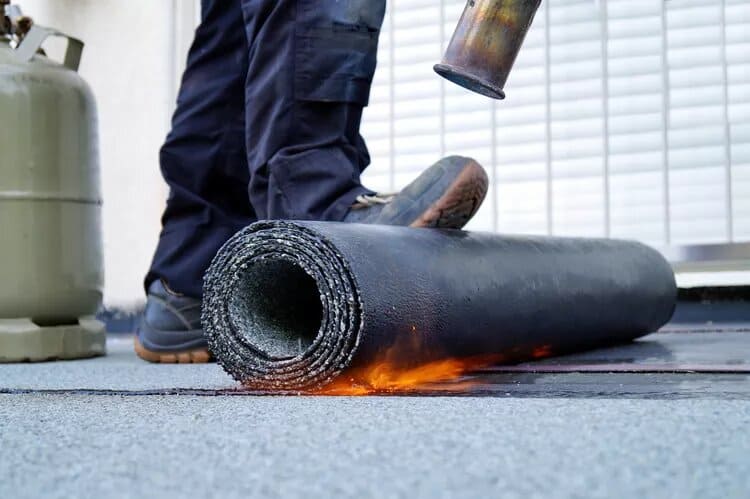
Average cost of rolled roofing: $1.50 to $2.00 per square foot
When it comes to low-slope residential roofs and utilitarian structures like sheds and workshops, rolled roofing emerges as a cost-effective champion. Its simplicity, functionality, and wallet-friendly nature make it a go-to option for those seeking a practical roofing solution.
Rolled roofing material comes in long rolls, typically about 100 square feet in area and 3 feet wide. Comprising mineral-impregnated and asphalt-impregnated layers topped with mineral granules, this material is designed for efficiency and utility. It may lack the ornate allure of some other roofing materials, but it’s perfectly suited for applications where aesthetics take a back seat.
Affordability is a hallmark of rolled roofing, with an average cost ranging from $1.50 to $2.00 per square foot. This budget-friendly nature makes it an appealing choice for budget-conscious homeowners and projects where functional coverage is the primary concern.
While rolled roofing might not be a showstopper in terms of aesthetics, its practicality shines through. It’s an excellent option for workshops or sheds, where the emphasis is on protection rather than appearances. Application is swift and convenient, and it can be achieved either through the torch-down method or using roofing nails.
It’s important to note that rolled roofing typically lasts around 5 to 8 years before needing replacement. While it may not boast the longevity of some other roofing materials, its affordability and ease of installation make it a viable choice for shorter-term needs.
2. Built-Up Roofing (BUR)
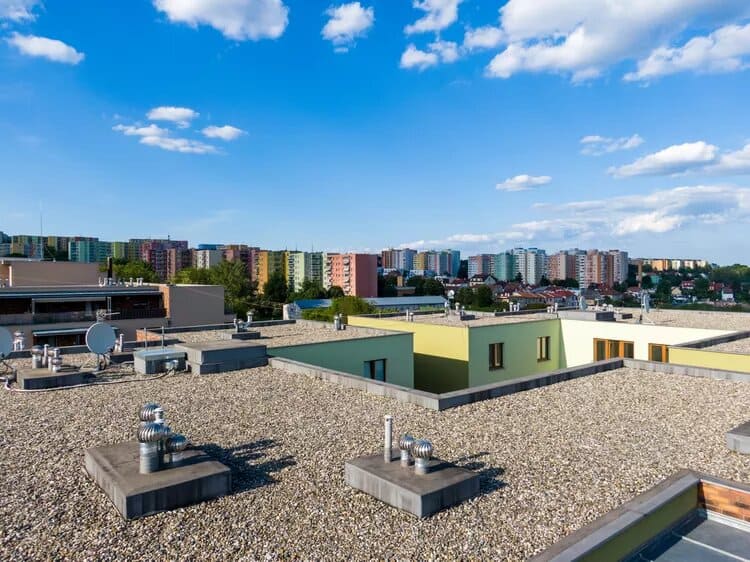
Average cost of built-up roofing: $2.50 to $5 per square foot
Built-Up Roofing (BUR) stands as a testament to the enduring nature of roofing solutions. With its origins tracing back through time, BUR has established itself as one of the oldest and most reliable choices for flat roofs or low-pitch roofs.
The hallmark of BUR lies in its construction, involving the layering of multiple roofing felts impregnated with hot asphalt. These layers are meticulously overlapped, resulting in a barrier that is two to four layers thick. But it’s the final touch that truly seals the deal: a layer of finely crushed stone, meticulously embedded in hot tar, crowns the structure. This combination creates a roof that not only exudes strength but also forms an impenetrable shield against the elements.
Built-Up Roofing has earned its stripes due to its remarkable durability. A properly installed BUR roof can stand the test of time, with a lifespan that often extends from 20 to 30 years. This impressive longevity has made BUR a go-to choice for structures requiring reliable, long-lasting protection.
While the core construction of BUR may harken to traditions of the past, its capabilities are very much relevant in the present. It remains a top choice for scenarios where low-pitch or flat roofs demand robust performance. BUR offers a blend of practicality and strength that stands unwavering against the challenges of weather and time.
3. Membrane Roofing
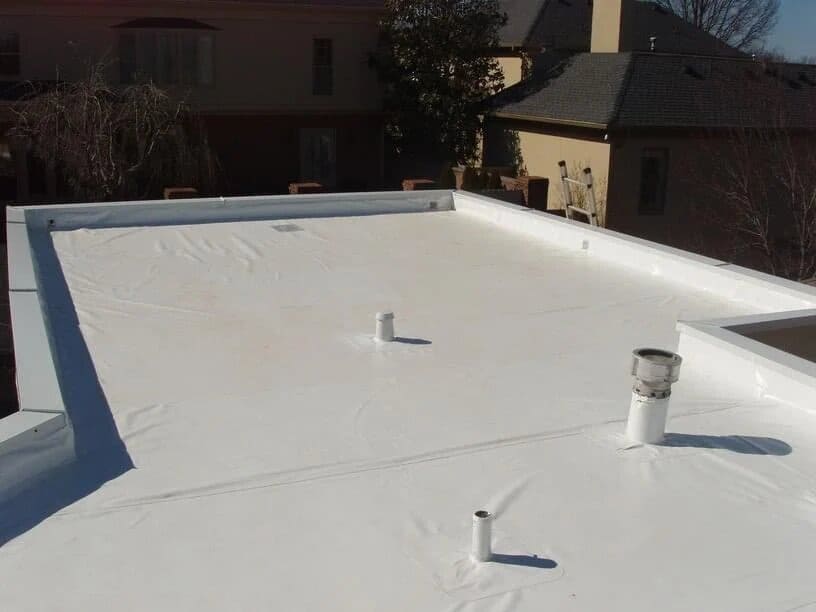
Average cost of membrane roofing: $4 to $8 per square foot
When it comes to flat roofs or those with very low pitches, membrane roofing emerges as a contemporary champion. This roofing approach offers a range of solutions, each designed to create a seamless and effective barrier against the elements.
The beauty of membrane roofing lies in its versatility, offering various types of membranes to cater to specific needs. These membranes include Neoprene (polychloroprene), EPDM (ethylene propylene diene monomer), PVC (polyvinyl chloride), chlorinated polyethylene, chlorosulfonated polyethylene sheets, and polymer-modified bitumen.
One standout among these options is EPDM, often hailed as “rubber roofing.” This synthetic roofing material shares similarities with rolled asphalt roofing, with the crucial distinction of being applied in larger sheets. This reduces the number of seams, thereby minimizing potential points of water infiltration.
EPDM, in particular, brings durability to the forefront. With proper maintenance, a well-installed EPDM membrane roof can offer a lifespan ranging from 20 to 35 years or even more. This longevity underscores its value as a roofing solution that can stand the test of time.
4. Asphalt Composite Shingles
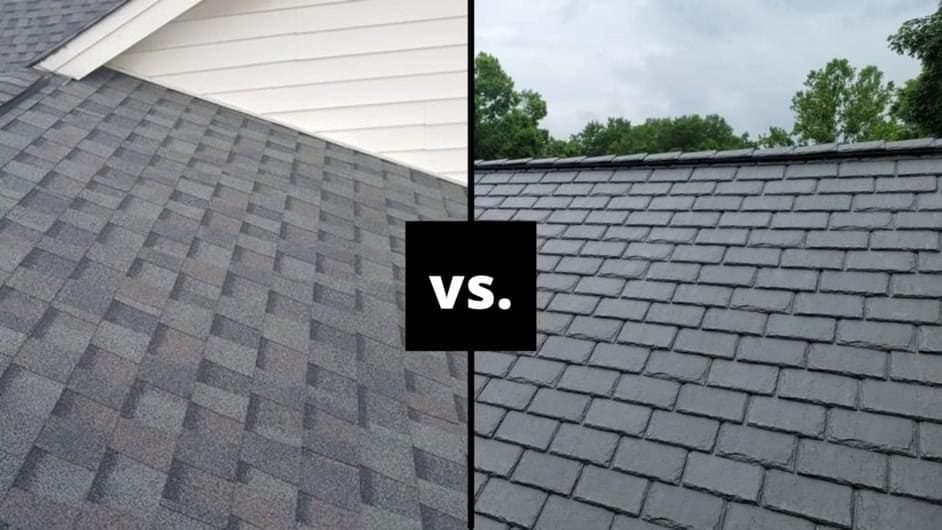
Average cost of asphalt composite shingles: $1.50 to $4.50 or more per square foot
In the realm of roofing materials across North America, asphalt composite shingles reign supreme as the top choice. Crafted from a fiberglass base overlaid with asphalt and mineral granules or coated with asphalt, these three-tab shingles stand as a versatile and reliable option for a wide range of home roofing needs.
The blend of fiberglass and asphalt results in a roofing material that strikes an impressive balance between weight and durability. Fiberglass asphalt shingles, though lightweight, possess remarkable strength, making them well-suited to withstand the demands of various weather conditions. On the other hand, organic asphalt shingles, while slightly heavier, retain their durability, showcasing the resilience that homeowners seek.
The practicality of asphalt composite shingles extends to their ease of installation and maintenance.
It’s important to note that the lifespan of a roof covered in asphalt composite shingles varies based on several factors. Quality of the shingles and prevailing conditions both contribute to this range. Generally, homeowners can anticipate a lifespan ranging from 12 to 30 years, a testament to the durability and reliability of this roofing choice.
5. Standing Seam Metal Roofing
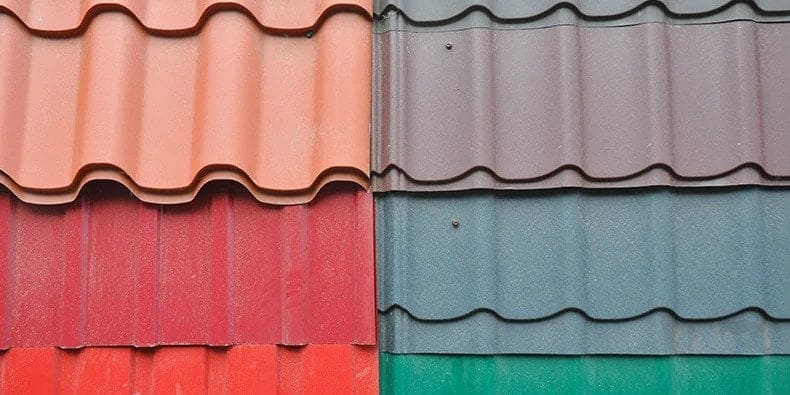
Average cost of standing seam metal roofing: $10 to $16 per square foot
When it comes to roofing options that marry strength, functionality, and aesthetics, metal roofs shine as a formidable contender. Among the various choices within the metal roofing realm, the standing seam roof emerges as a prevalent and effective solution.
Standing seam roofs derive their name from their distinct design, where aluminum or steel panels come together in raised seams that cleverly interlock, forming a barrier that effectively wards off moisture infiltration. This interlocking mechanism not only enhances protection but also adds a touch of architectural intrigue to the roofline.
The allure of metal roofing extends beyond its structural appeal—it is increasingly embraced in regions that grapple with heavy snowfall or wildfire risks. The inherent fireproof nature of metal makes it a resilient choice for areas prone to such hazards, adding an extra layer of security to homes.
One of the remarkable aspects of metal roofing is its longevity. Metal roofs are renowned for their durability, with a potential lifespan that ranges from 30 to 50 years and, in some extraordinary cases, even up to 75 years. The material’s resistance to the elements, including the unforgiving toll of time, makes it a prudent and sustainable investment.
6. Metal Shingles/Shakes
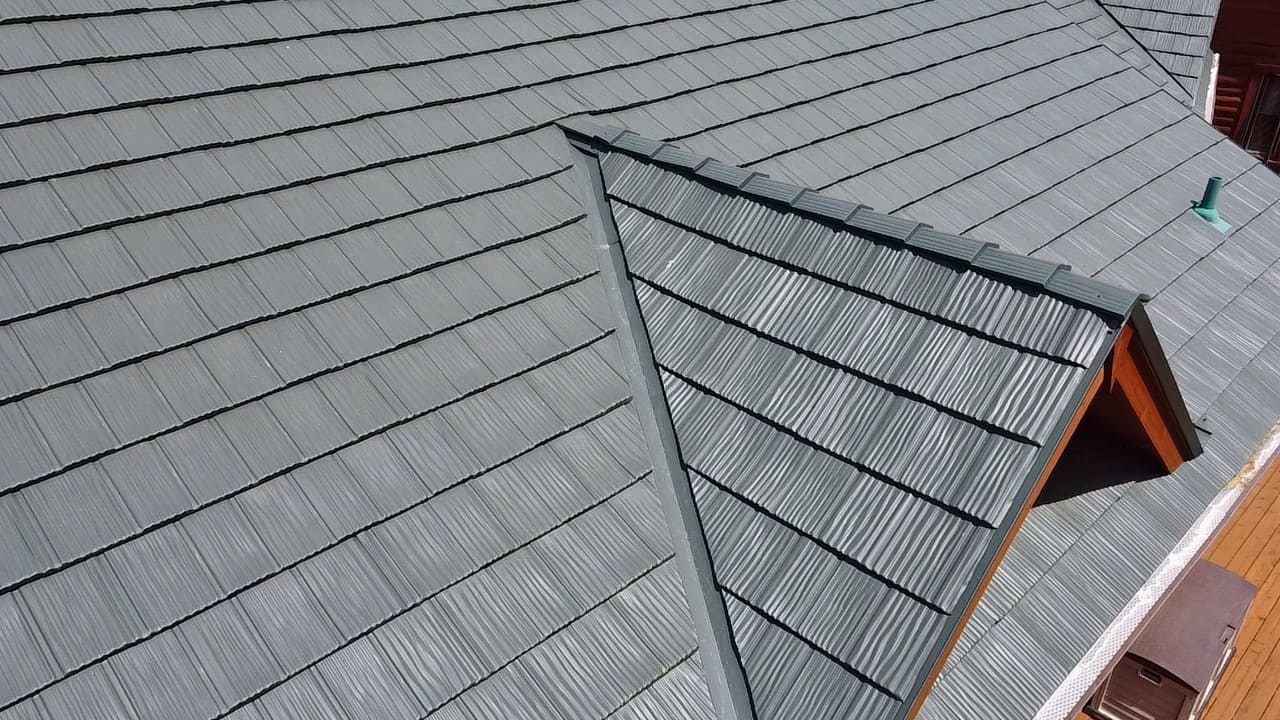
Average cost of metal shingles: $8 to $16 or so per square foot
For homeowners who seek the best of both worlds—uncompromised aesthetics and the resilience of metal roofing—steel or aluminum shingles and shakes emerge as a compelling solution. These roofing options offer a harmonious blend of style and strength, catering to those who desire the advantages of metal without the appearance of traditional standing seam roofs.
Metal shingles and shakes don’t just mimic the aesthetics of other roofing types; they also inherit the qualities that make metal a coveted choice. Finished with a high-quality baked-on coating or adorned with mineral granules, these roofing elements are designed to withstand the tests of time and the elements. The result is a roof that stands as a testament to both endurance and style.
Longevity is a hallmark of metal shingles and shakes. With proper care and maintenance, they can easily last for 30 to 50 years, offering homeowners a prolonged period of protection and peace of mind. This impressive lifespan underscores the value of investing in roofing materials that embrace both beauty and durability.
7. Wood Shingles/Shakes
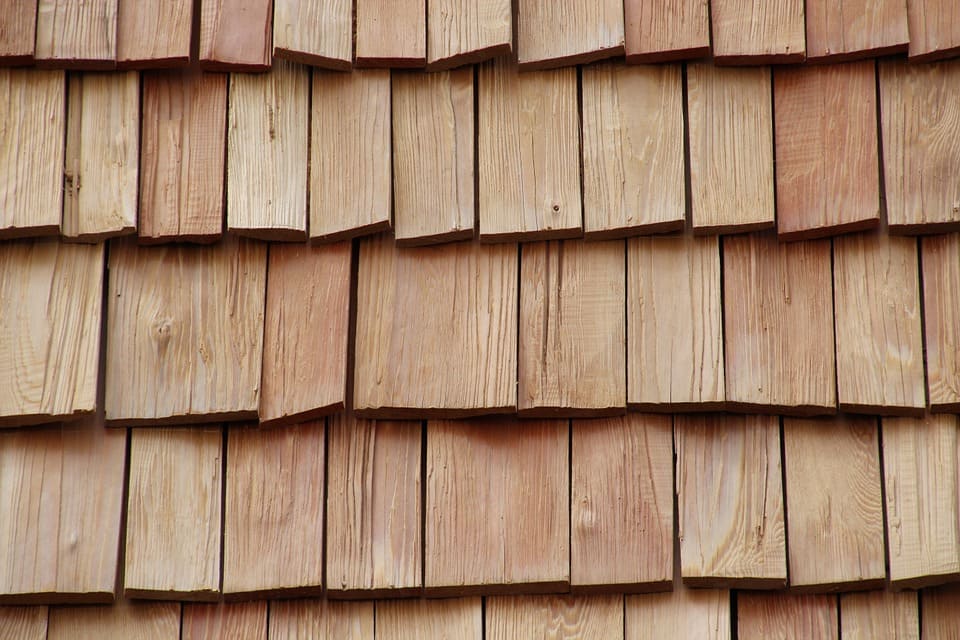
Average cost of wood shingles/shakes: $4.50 to $9 per square foot (shingles); $6.50 to $14 per square foot (shakes)
Wood roofs stand as a testament to timeless beauty, invoking a sense of charm that few other materials can match. However, like all things of great allure, wood roofs come with their own set of considerations. While they grace homes with an unparalleled aesthetic, they also demand careful thought when it comes to practicality, longevity, and environmental factors.
A distinction exists between wood shakes and shingles, both originating from natural wood but undergoing distinct processes. Shingles are slender, wedge-shaped slabs achieved through precise sawing, while shakes are thicker, rough-textured wedges resulting from wood splitting. This variation in production contributes to the textural diversity and visual appeal of wood roofing.
However, wood roofs present a delicate balance of advantages and limitations. While they possess undeniable allure, they have a shorter lifespan compared to some other roofing materials. Additionally, they are less suited for regions prone to excessive moisture or wildfire risks. In areas abundant with rainfall, the longevity of a wood shingle or shake roof might range from 20 to 30 years, whereas drier climates can extend this span to a remarkable 60 years.
8. Clay Tile
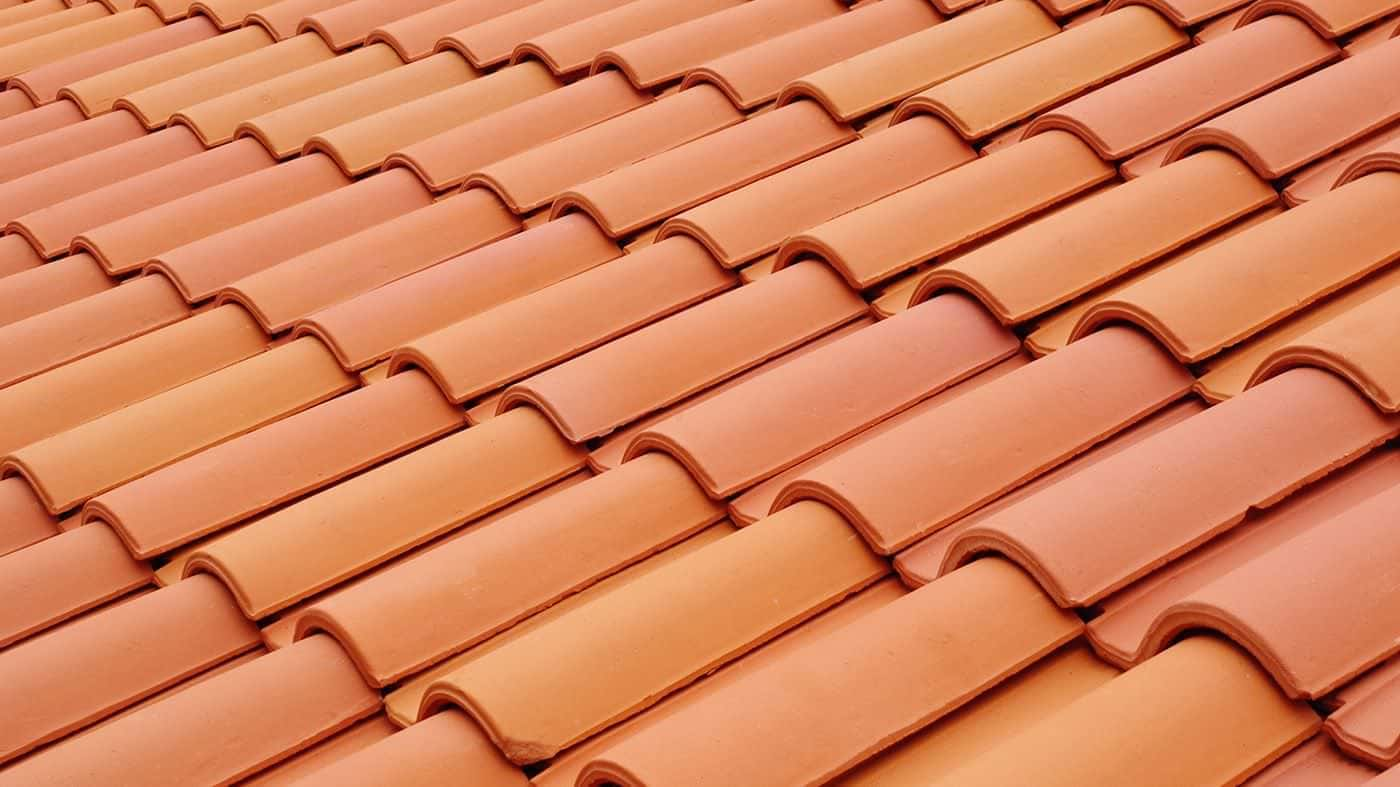
Average cost of clay tile: $10 to $18 per square foot (though more uncommon ceramic tiles can run as much as $30 per square foot)
Clay tile roofs stand as a testament to the harmonious blend of artistry and durability. Crafted from earthen clays meticulously molded into intricate rolled or interlocking forms, these roofs are a celebration of tradition and longevity. Fired to achieve a remarkable hardness, clay tiles embark on a journey that transforms them into an enduring masterpiece atop homes.
Beyond aesthetics, clay tile roofs offer practical benefits that make them a natural choice for certain regions. Their resilience to the elements makes them particularly well-suited for hot climates and areas affected by salt air, such as Southern coastal regions or desert landscapes. These roofs not only withstand the scorching sun but also endure the challenges posed by the sea breeze and arid conditions.
Durability is the hallmark of clay tile roofs. Among various roofing materials, clay stands as one of the most enduring options. Its robust nature translates into exceptional longevity, with the potential to extend well beyond a century. This remarkable lifespan isn’t just a testament to the material’s strength—it’s a reflection of the enduring beauty and value that clay tile roofs bestow upon homes.
9. Concrete Tile
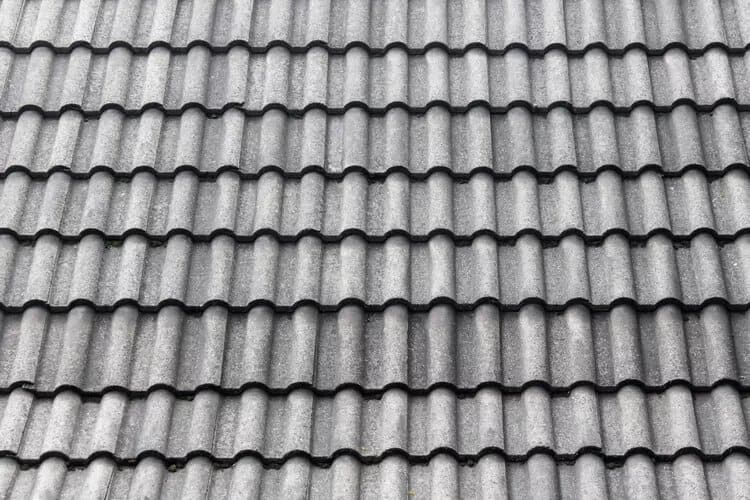
Average cost of concrete tile: $10 to $20 or more per square foot
In the world of roofing, concrete tile emerges as a formidable alternative to clay tile, offering comparable installation techniques and benefits with a touch of economic advantage. This roofing solution stands as a testament to the art of transformation, molding standard sand-mix concrete into structures that embody both aesthetics and endurance.
The palette of concrete tiles is as versatile as the imagination allows, with the ability to be colored to match desired hues. This creative freedom ensures that each roof is a canvas of individuality, reflecting the personal tastes of homeowners and the architecture of their dwellings. Some concrete tiles even receive a decorative coating, adding an extra layer of style to the already vibrant palette.
The inherent sturdiness of concrete tiles ensures that homes remain steadfast even in the face of challenging weather conditions.
The longevity of concrete tile roofs is another remarkable feature. With proper care and maintenance, a well-installed concrete tile roof can provide reliable protection for 50 years or even longer. This extended lifespan underscores the value of investing in a roofing material that stands the test of time.
10. Slate Shingles
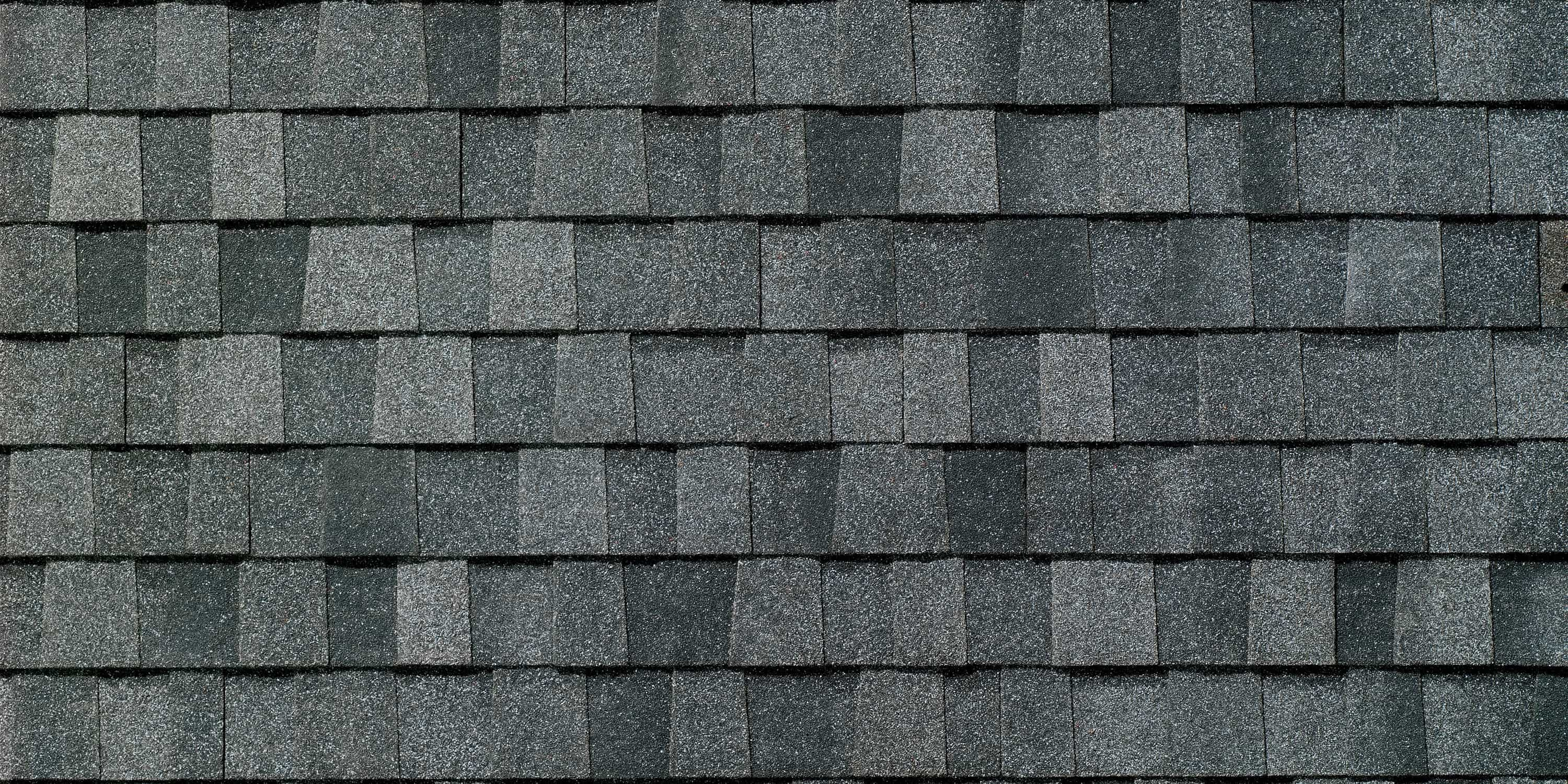
Average cost of slate shingles: $10 to $30 per square foot, depending on hard or soft slate
Slate roofing stands as a resplendent emblem of luxury, gracing homes with an elegance that transcends time. This roofing material, characterized by its timeless beauty and remarkable longevity, is an investment in aesthetics and endurance.
Authenticity defines slate roofing, where thin sheets of genuine stone emerge as the primary building blocks. The inherent nature of slate to cleave into these slender sheets makes it an ideal material for roofing. Quarrying slate is a process that balances the stone’s natural tendencies, transforming it into a material that not only captivates the eye but also stands strong against the elements.
Choosing slate is a decision that transcends generations. When you opt for a slate roof, you’re embracing a roofing solution that can outlast the test of time. The impressive longevity of slate tiles ranges from 75 to 150 years or even more. This means that once a slate tile roof is in place, it’s likely to be the final roof replacement you’ll ever need to consider.
11. Synthetic (Rubber) Slate Tile
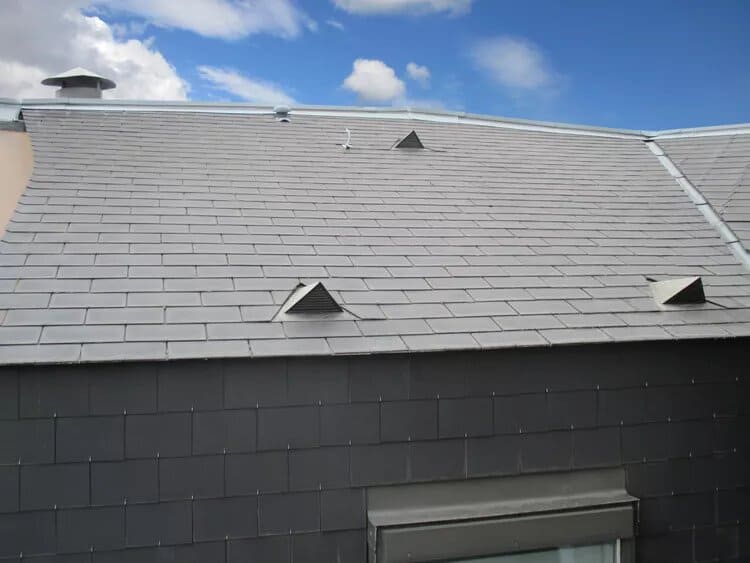
Average cost of synthetic (rubber) slate tile: $9 to $12 or so per square foot
In the realm of roofing innovation, synthetic slate shingles emerge as a testament to the marriage of artistry and modern engineering. These shingles, crafted with remarkable precision, offer a convincing imitation of natural slate without the weighty burden it carries. As a lightweight alternative, synthetic slate harnesses the power of engineered polymers, recycled plastic, and rubber, redefining roofing aesthetics and practicality.
One of the defining attributes of synthetic slate is its lightweight nature. While natural slate is renowned for its beauty, it carries a substantial weight that some structures struggle to support. Synthetic slate shingles provide a solution for such scenarios, offering the timeless appeal of slate without the load-bearing challenges.
While the durability of synthetic slate may not rival that of genuine stone, it presents a worthy compromise. Synthetic slate shingles often come adorned with robust warranties, extending up to 50 years. This assurance not only underscores the manufacturer’s confidence in the material’s capabilities but also provides homeowners with the peace of mind that their investment is safeguarded.
12. Living Roof
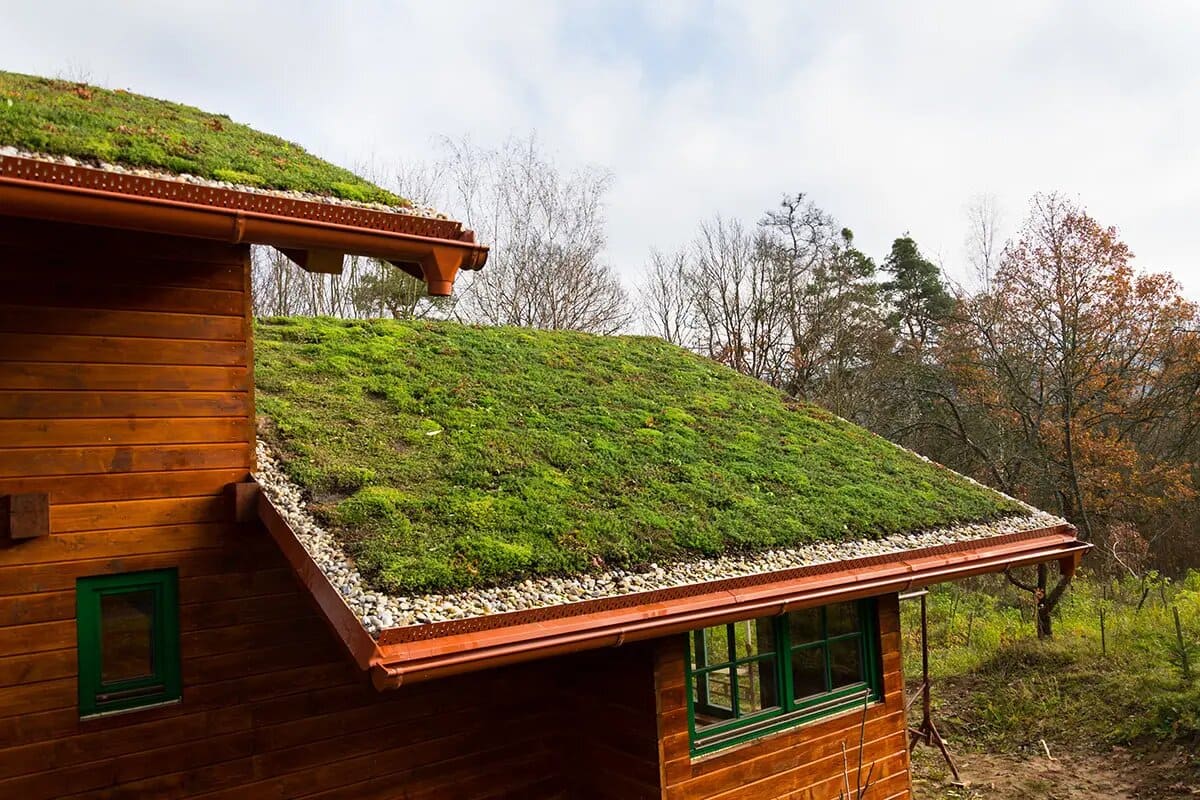
Average cost of a living roof: Varies widely
In the realm of roofing innovation, a green or living roof emerges as an unexpected yet promising choice—one that challenges conventions and breathes life into architectural possibilities. While moss and other living plant materials on a roof may raise concerns when uncontrolled, a well-planned living roof presents a symbiotic relationship between shelter and nature, offering benefits that extend beyond traditional roofing materials.
A green roof, in its essence, is a tribute to nature’s resilience. Beyond merely sheltering a home, it actively participates in the restoration of the ecosystem. Through its unique design, a living roof plays a role in air purification by removing pollutants from the atmosphere. It extends its influence to thermal insulation, contributing to energy efficiency and comfort within the dwelling. Rainwater finds a purpose as a living roof absorbs and manages this precious resource, effectively contributing to water conservation.
Sustaining the vitality of a living roof requires diligent maintenance. Regular care ensures the continued health and longevity of the living ecosystem atop your home, transforming it into a flourishing haven that echoes the cycles of the natural world.
CONCLUSION:
As we conclude our exploration of the diverse world of roofing materials, we find ourselves at a crossroads of options, each offering a unique blend of aesthetics, durability, and budget considerations. The journey through asphalt composite shingles, metal, wood, slate, concrete, synthetic slate, and even living roofs has provided a panoramic view of roofing possibilities that cater to various architectural styles, climates, and preferences.
Selecting the ideal roofing material for your home involves a careful balance of factors. Your budget, architectural preferences, and the specific demands of your environment all play pivotal roles in this decision-making process. Each roofing material has its own set of advantages and limitations, offering a unique tapestry of benefits that align with different homeowner priorities.
For those seeking an affordable yet reliable option, asphalt composite shingles present a versatile solution that blends cost-effectiveness with respectable durability. Metal roofs, on the other hand, offer longevity and resilience, making them a wise choice for homeowners who view their roof as a long-term investment. Wood and synthetic slate roofs combine aesthetics and practicality, each catering to unique architectural preferences and load-bearing capabilities.
If you’re captivated by the allure of tradition and willing to invest in timeless elegance, slate and concrete tile roofs extend an enduring promise of beauty and longevity. Meanwhile, the eco-conscious homeowner may find the concept of a living roof appealing, as it fosters a harmonious connection between shelter and nature.
Ultimately, the roofing material that suits you best depends on your budget and what you value most in a roof. By assessing your financial parameters, architectural preferences, and the specific conditions of your location, you can pinpoint the roofing solution that seamlessly integrates into your lifestyle and enhances the beauty and protection of your home.

